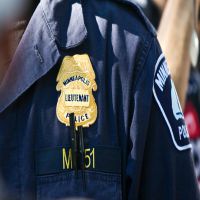

* denotes required fields
YOU WILL RECEIVE PERIODIC UPDATES FROM COLOROFCHANGE.ORG. YOU MAY UNSUBSCRIBE AT ANY TIME.
† MOBILE ALERTS FROM COLOROFCHANGE. PERIODIC MESSAGES. MSG & DATA RATES MAY APPLY. TEXT STOP TO 225568 TO STOP RECEIVING MESSAGES. TEXT HELP TO 225568 FOR MORE INFORMATION. TERMS AND CONDITIONS

Police brutality and violence against Black communities is out of control. Body cameras alone will not stop police violence against our communities, but with the right policies in place, they can be a strong tool for holding MPD accountable. But if we don’t demand the the right policies there is a real risk that these devices could become instruments of injustice, rather than tools for accountability. This is why it’s so critical we make our voices heard during the Police Oversight Commission's listening tour on body cameras.
Dear Commissioners,
To ensure that the Minneapolis Police Department’s police-worn body cameras are properly used to enhance police accountability and to protect our civil rights we demand that the Minneapolis Police Conduct Oversight Commission commits to the including the following policies:
Continue to develop camera policies in public with the input of the community and civil rights advocates. Current policies must always be publicly available, and any policy changes must also be made in consultation with the community.
Commit to a set of narrow and well-defined purposes for which cameras and their footage may be used. In particular, facial recognition and other biometric technologies must be strictly limited: if they are used together with body cameras, officers will have even greater visibility into heavily policed communities—where cameras will be abundant—than into other communities where cameras will be rare. Without this commitment such technologies could amplify existing disparities in law enforcement practices across communities.
Specify clear operational policies for recording, retention, and access, and enforce strict disciplinary protocols for policy violations. While some types of law enforcement interactions (e.g., when attending to victims of domestic violence) may happen off-camera, the vast majority of interactions with the public—including all that involve the use of force—should be captured on video. Departments must also adopt systems to monitor and audit access to recorded footage, and secure footage against unauthorized access and tampering.
Make footage available to promote accountability with appropriate privacy safeguards in place. At a minimum: (1) footage that captures police use of force should be made available to the public and press upon request, and (2) upon request, footage should be made available in a timely manner to any filmed subject seeking to file a complaint, to criminal defendants, and to the next-of-kin of anyone whose death is related to the events captured on video.
Preserve the independent evidentiary value of officer reports by prohibiting officers from viewing footage before filing their reports. Footage of an event presents a partial—and sometimes misleading—perspective of how events unfolded. Pre-report viewing could cause an officer to conform the report to what the video appears to show, rather than what the officer actually saw. This commitment is crucial to ensuring that these technologies enhance civil liberties and don’t further discriminatory policing.
Without these safeguards police-worn cameras could compound problems of over-surveillance and biased policing that are already detrimental to communities of color. Body cameras can only be used as a tool for holding MPD accountable with these civil liberty protecting policies.
Sincerely,